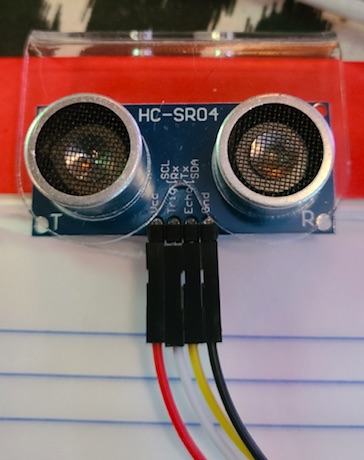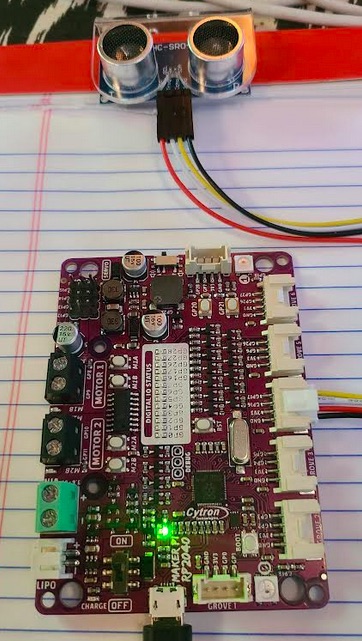Ultrasonic Ping Sensor Lab
The Grove sensors on our Maker Pi RP2040 only supply 3.3 volts. So the standard very popular low cost HC-SR04 will not work, since it requires 5 volts of power. We have two options. One is to get a separate 5V power source, but the other is to purchase the new HC-SR04P (for Pico?) sensor that will work with our 3.3 volt power on our Grove connector.
Using the Grove 4 connection wire the HC-SP04P sensor with the trigger on GPIO-16 (White cable) and the echo on GPIO-17 (Yellow cable), VCC (Red cable), and GND (Black cable)

All wired up

1
2
3
4
5
6
7
8
9
10
11
12
13
14
15
16
17
18
19
20
21
22
23
24
25
26
27
28
29
30
31 | # Sample code to test HC-SR04 Ultrasonice Ping Sensor
# Connect GND to any GND pin on the Pico
# Connnect VCC to VBUS or 5 Volt power
from machine import Pin, Timer
import utime
TRIGGER_PIN = 16 # With USB on the top, this pin is the bottom left corner
ECHO_PIN = 17 # One up from bottom left corner
# Init HC-SR04 pins
trigger = Pin(TRIGGER_PIN, Pin.OUT) # send trigger out to sensor
echo = Pin(ECHO_PIN, Pin.IN) # get the delay interval back
def ping():
trigger.low()
utime.sleep_us(2) # Wait 2 microseconds low
trigger.high()
utime.sleep_us(5) # Stay high for 5 miroseconds
trigger.low()
while echo.value() == 0:
signaloff = utime.ticks_us()
while echo.value() == 1:
signalon = utime.ticks_us()
timepassed = signalon - signaloff
distance = (timepassed * 0.0343) / 2
return distance
while True:
print("Distance:", ping(), "cm")
utime.sleep(.25)
|
More advanced version with sound
1
2
3
4
5
6
7
8
9
10
11
12
13
14
15
16
17
18
19
20
21
22
23
24
25
26
27
28
29
30
31
32
33
34
35
36
37
38
39
40
41
42
43
44
45
46
47
48
49
50 | # Sample code to test HC-SR04 Ultrasonice Ping Sensor
# Connect GND to any GND pin on the Pico
# Connnect VCC to VBUS or 5 Volt power
from machine import Pin, Timer, PWM
import utime
TRIGGER_PIN = 16 # With USB on the top, this pin is the bottom left corner
ECHO_PIN = 17 # One up from bottom left corner
# Init HC-SR04 pins
trigger = Pin(TRIGGER_PIN, Pin.OUT) # send trigger out to sensor
echo = Pin(ECHO_PIN, Pin.IN) # get the delay interval back
BUZZER_PORT = 22
buzzer = PWM(Pin(BUZZER_PORT))
# Note the non-linear increases in frequency - note that some are louder
tone_freq = [100, 150, 210, 280, 350, 450, 580, 750, 850, 950, 1000]
def playtone(frequency):
buzzer.duty_u16(1000)
buzzer.freq(frequency)
def bequiet():
buzzer.duty_u16(0)
def ping():
trigger.low()
utime.sleep_us(2) # Wait 2 microseconds low
trigger.high()
utime.sleep_us(5) # Stay high for 5 miroseconds
trigger.low()
while echo.value() == 0:
signaloff = utime.ticks_us()
while echo.value() == 1:
signalon = utime.ticks_us()
timepassed = signalon - signaloff
distance = (timepassed * 0.0343) / 2
return distance
while True:
dist=round(ping())
print("Distance:", dist, "cm")
if dist < 20:
print("Panic")
playtone(350)
# Beep faster the closer you get
utime.sleep(.05/(20/dist))
bequiet()
utime.sleep(.1)
|
Link to Sample Ping Lab
This code is very similar to the previous ping lab but with the different GPIO lines used.
Link to Standard Ping Lab

